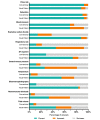Comparing Classroom Instruction to Individual Instruction as an Approach to Teach Avatar-Based Patient Monitoring With Visual Patient: Simulation Study
- PMID: 32205304
- PMCID: PMC7206517
- DOI: 10.2196/17922
Comparing Classroom Instruction to Individual Instruction as an Approach to Teach Avatar-Based Patient Monitoring With Visual Patient: Simulation Study
Erratum in
-
Correction: Comparing Classroom Instruction to Individual Instruction as an Approach to Teach Avatar-Based Patient Monitoring With Visual Patient: Simulation Study.JMIR Med Educ. 2020 Oct 1;6(2):e24459. doi: 10.2196/24459. JMIR Med Educ. 2020. PMID: 33001840 Free PMC article.
Abstract
Background: Visual Patient is an avatar-based alternative to standard patient monitor displays that significantly improves the perception of vital signs. Implementation of this technology in larger organizations would require it to be teachable by brief class instruction to large groups of professionals. Therefore, our study aimed to investigate the efficacy of such a large-scale introduction to Visual Patient.
Objective: In this study, we aimed to compare 2 different educational methods, one-on-one instruction and class instruction, for training anesthesia providers in avatar-based patient monitoring.
Methods: We presented 42 anesthesia providers with 30 minutes of class instruction on Visual Patient (class instruction group). We further selected a historical sample of 16 participants from a previous study who each received individual instruction (individual instruction group). After the instruction, the participants were shown monitors with either conventional displays or Visual Patient displays and were asked to interpret vital signs. In the class instruction group, the participants were shown scenarios for either 3 or 10 seconds, and the numbers of correct perceptions with each technology were compared. Then, the teaching efficacy of the class instruction was compared with that of the individual instruction in the historical sample by 2-way mixed analysis of variance and mixed regression.
Results: In the class instruction group, when participants were presented with the 3-second scenario, there was a statistically significant median increase in the number of perceived vital signs when the participants were shown the Visual Patient compared to when they were shown the conventional display (3 vital signs, P<.001; effect size -0.55). No significant difference was found for the 10-second scenarios. There was a statistically significant interaction between the teaching intervention and display technology in the number of perceived vital signs (P=.04; partial η2=.076). The mixed logistic regression model for correct vital sign perception yielded an odds ratio (OR) of 1.88 (95% CI 1.41-2.52; P<.001) for individual instruction compared to class instruction as well as an OR of 3.03 (95% CI 2.50-3.70; P<.001) for the Visual Patient compared to conventional monitoring.
Conclusions: Although individual instruction on Visual Patient is slightly more effective, class instruction is a viable teaching method; thus, large-scale introduction of health care providers to this novel technology is feasible.
Keywords: avatar; computer-assisted; diagnosis.
©Julian Werner Rössler, Alexander Kaserer, Benjamin Albiez, Julia Braun, Jan Breckwoldt, Donat Rudolf Spahn, Christoph Nöthiger, David Werner Tscholl. Originally published in JMIR Medical Education (http://mededu.jmir.org), 23.04.2020.
Conflict of interest statement
Conflicts of Interest: The University of Zurich (Zurich, Switzerland) and Koninklijke Philips N.V. (Amsterdam, Netherlands) entered a joint development and licensing agreement to develop avatar-based monitoring software based on technology that is owned by the University and described in this manuscript. As part of their contract with the University, as designated inventors, the authors DWT and CBN may receive royalties.
Figures






Similar articles
-
Situation Awareness-Oriented Patient Monitoring with Visual Patient Technology: A Qualitative Review of the Primary Research.Sensors (Basel). 2020 Apr 9;20(7):2112. doi: 10.3390/s20072112. Sensors (Basel). 2020. PMID: 32283625 Free PMC article. Review.
-
The Mechanisms Responsible for Improved Information Transfer in Avatar-Based Patient Monitoring: Multicenter Comparative Eye-Tracking Study.J Med Internet Res. 2020 Mar 16;22(3):e15070. doi: 10.2196/15070. J Med Internet Res. 2020. PMID: 32175913 Free PMC article.
-
Avatar-based versus conventional vital sign display in a central monitor for monitoring multiple patients: a multicenter computer-based laboratory study.BMC Med Inform Decis Mak. 2020 Feb 10;20(1):26. doi: 10.1186/s12911-020-1032-4. BMC Med Inform Decis Mak. 2020. PMID: 32041584 Free PMC article.
-
Avatar-based versus conventional patient monitoring with distant vision: a computer-based simulation study.J Clin Monit Comput. 2024 Nov 15. doi: 10.1007/s10877-024-01239-x. Online ahead of print. J Clin Monit Comput. 2024. PMID: 39546214
-
Effectiveness of avatar-based technology in patient education for improving chronic disease knowledge and self-care behavior: a systematic review.JBI Database System Rev Implement Rep. 2019 Jun;17(6):1101-1129. doi: 10.11124/JBISRIR-2017-003905. JBI Database System Rev Implement Rep. 2019. PMID: 31021975
Cited by
-
Visual Blood, a 3D Animated Computer Model to Optimize the Interpretation of Blood Gas Analysis.Bioengineering (Basel). 2023 Feb 25;10(3):293. doi: 10.3390/bioengineering10030293. Bioengineering (Basel). 2023. PMID: 36978684 Free PMC article.
-
Improving Visual-Patient-Avatar Design Prior to Its Clinical Release: A Mixed Qualitative and Quantitative Study.Diagnostics (Basel). 2022 Feb 21;12(2):555. doi: 10.3390/diagnostics12020555. Diagnostics (Basel). 2022. PMID: 35204644 Free PMC article.
-
Situation Awareness-Oriented Patient Monitoring with Visual Patient Technology: A Qualitative Review of the Primary Research.Sensors (Basel). 2020 Apr 9;20(7):2112. doi: 10.3390/s20072112. Sensors (Basel). 2020. PMID: 32283625 Free PMC article. Review.
-
User Perceptions of Avatar-Based Patient Monitoring for Intensive Care Units: An International Exploratory Sequential Mixed-Methods Study.Diagnostics (Basel). 2023 Nov 6;13(21):3391. doi: 10.3390/diagnostics13213391. Diagnostics (Basel). 2023. PMID: 37958287 Free PMC article.
-
Antibacterial Property of Silver Nanoparticles Green Synthesized from Stachys schtschegleevii Plant Extract on Urinary Tract Infection Bacteria.Curr Microbiol. 2024 Apr 9;81(5):135. doi: 10.1007/s00284-024-03664-2. Curr Microbiol. 2024. PMID: 38592462
References
LinkOut - more resources
Full Text Sources

